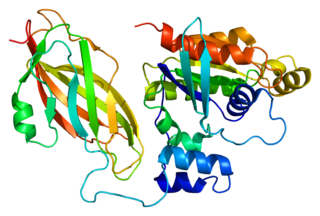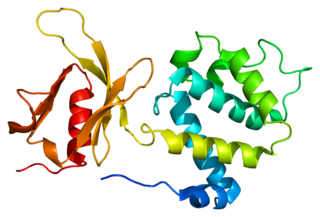Related Research Articles

Complement receptor type 1 (CR1) also known as C3b/C4b receptor or CD35 is a protein that in humans is encoded by the CR1 gene.

Vimentin is a structural protein that in humans is encoded by the VIM gene. Its name comes from the Latin vimentum which refers to an array of flexible rods.

In humans, clusterin (CLU) is encoded by the CLU gene on chromosome 8. CLU is an extracellular molecular chaperone which binds to misfolded proteins in body fluids to neutralise their toxicity and mediate their cellular uptake by receptor-mediated endocytosis. Once internalised by cells, complexes between CLU and misfolded proteins are trafficked to lysosomes where they are degraded. CLU is involved in many diseases including neurodegenerative diseases, cancers, inflammatory diseases, and aging.

Potyviridae is a family of positive-strand RNA viruses that encompasses more than 30% of known plant viruses, many of which are of great agricultural significance. The family has 12 genera and 235 species, three of which are unassigned to a genus.

Heat shock 70 kDa protein 8 also known as heat shock cognate 71 kDa protein or Hsc70 or Hsp73 is a heat shock protein that in humans is encoded by the HSPA8 gene on chromosome 11. As a member of the heat shock protein 70 family and a chaperone protein, it facilitates the proper folding of newly translated and misfolded proteins, as well as stabilize or degrade mutant proteins. Its functions contribute to biological processes including signal transduction, apoptosis, autophagy, protein homeostasis, and cell growth and differentiation. It has been associated with an extensive number of cancers, neurodegenerative diseases, cell senescence, and aging.

Calbindins are three different calcium-binding proteins: calbindin, calretinin and S100G. They were originally described as vitamin D-dependent calcium-binding proteins in the intestine and kidney of chicks and mammals. They are now classified in different subfamilies as they differ in the number of Ca2+ binding EF hands.

The glucagon receptor is a 62 kDa protein that is activated by glucagon and is a member of the class B G-protein coupled family of receptors, coupled to G alpha i, Gs and to a lesser extent G alpha q. Stimulation of the receptor results in the activation of adenylate cyclase and phospholipase C and in increased levels of the secondary messengers intracellular cAMP and calcium. In humans, the glucagon receptor is encoded by the GCGR gene.

Protein tyrosine phosphatase, receptor type, C also known as PTPRC is an enzyme that, in humans, is encoded by the PTPRC gene. PTPRC is also known as CD45 antigen, which was originally called leukocyte common antigen (LCA).
Tonofibrils are cytoplasmic protein structures in epithelial tissues that converge at desmosomes and hemidesmosomes. They consist of fine fibrils in epithelial cells that are anchored to the cytoskeleton. They were discovered by Rudolf Heidenhain, and first described in detail by Louis-Antoine Ranvier in 1897.

Myosin regulatory light polypeptide 9 is a protein that in humans is encoded by the MYL9 gene.

A cyclin-dependent kinase inhibitor protein(also known as CKIs, CDIs, or CDKIs) is a protein which inhibits the enzyme cyclin-dependent kinase (CDK) and Cyclin activity by stopping the cell cycle if there are unfavorable conditions, therefore, acting as tumor suppressors. Cell cycle progression is stopped by Cyclin-dependent kinase inhibitor protein at the G1 phase. CKIs are vital proteins within the control system that point out whether the process of DNA synthesis, mitosis, and cytokines control one another. If a malfunction prevents the successful completion of DNA synthesis during the G1 phase, a signal is sent to delay or stop the progression to the S phase. Cyclin-dependent kinase inhibitor proteins are essential in the regulation of the cell cycle. If cell mutations surpass the cell cycle checkpoints during cell cycle regulation, it can result in various types of cancer.

Interleukin enhancer-binding factor 3 is a protein that in humans is encoded by the ILF3 gene.

Rac2 is a small signaling G protein, and is a member of the Rac subfamily of the family Rho family of GTPases. It is encoded by the gene RAC2.

40S ribosomal protein SA is a ribosomal protein that in humans is encoded by the RPSA gene. It also acts as a cell surface receptor, in particular for laminin, and is involved in several pathogenic processes.

Hsp70-binding protein 1 is a protein that in humans is encoded by the HSPBP1 gene.

40S ribosomal protein S21 is a protein, encoded in humans by the RPS21 gene.

BCL2/adenovirus E1B 19 kDa protein-interacting protein 3-like is a protein that in humans is encoded by the BNIP3L gene.

Talin-1 is a protein that in humans is encoded by the TLN1 gene. Talin-1 is ubiquitously expressed, and is localized to costamere structures in cardiac and skeletal muscle cells, and to focal adhesions in smooth muscle and non-muscle cells. Talin-1 functions to mediate cell-cell adhesion via the linkage of integrins to the actin cytoskeleton and in the activation of integrins. Altered expression of talin-1 has been observed in patients with heart failure, however no mutations in TLN1 have been linked with specific diseases.
The achaete-scute complex (AS-C) is a group of four genes in the fruit fly Drosophila melanogaster. These genes encode basic helix-loop-helix transcription factors that have been best studied in their regulation of nervous system development. Because of their role in specifying neuroblast fate, the genes of the AS-C are called proneural genes. However, the AS-C has non-proneural functions, such as specifying muscle and gut progenitors. Homologues of AS-C in other animals, including humans and other vertebrates, have similar functions.

Dual specificity protein phosphatase 23, also known as low molecular mass dual specificity phosphatase 3 (LDP-3), is an enzyme that in humans is encoded by the DUSP23 gene.
References
- ↑ Henney CS (1979). "The "triggering" of cytotoxic cell differentiation in secondary cultures by subcellular antigens". J. Immunol. 122 (5): 2134. doi:10.4049/jimmunol.122.5.2134.a. PMID 312858.